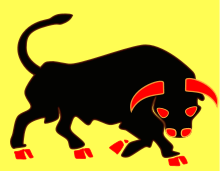British 11th Armoured Division
| 11th Armoured Division | |
|---|---|

Insignia of the 11th Armoured Division
|
|
| Active | 1941–1946 1952–1956 |
| Country |
|
| Branch |
|
| Type | Armoured |
| Size |
Division, 14,964 men 343 tanks |
| Nickname(s) | The Black Bull |
| Engagements | |
| Battle honours |
|
| Commanders | |
| Notable commanders |
Percy Hobart Charles Keightley George Roberts |
The 11th Armoured Division, also known as The Black Bull, was an armoured division of the British Army which was created in March 1941 during the Second World War. The division was formed in response to the unanticipated success of the German panzer divisions. The 11th Armoured was responsible for several major victories in the Battle of Normandy from in the summer of 1944, shortly after the D-Day landings of 6 June 1944, and it participated in the rapid advance across France, Belgium, and the Netherlands and, later, the Rhine crossing in March 1945, and later invaded Germany. It was disbanded in January 1946 and reformed towards the end of 1950. In 1956, it was converted into the 4th Infantry Division.
In Poland and western Europe in 1939 and 1940, the German armoured formations demonstrated what some observers felt were dramatically improved new tactics, leaving the Allied forces with a perceived need to address these developments. The continued evolution of the Royal Armoured Corps was the answer for the British Army.
The 11th Armoured Division was organized in March 1941, in Yorkshire under Major-General Percy Hobart. A veteran of the Royal Tank Corps, he had already strongly influenced the shape of the 7th Armoured Division, but his original and innovative ideas had led to his retirement from the army. Reinstated after the disasters of the Battle of France in 1940, he further realised his vision with the 11th Armoured. Under his leadership the Division adopted the “Charging Bull” as its emblem.
...
Wikipedia
